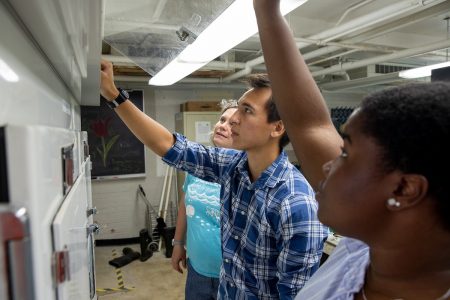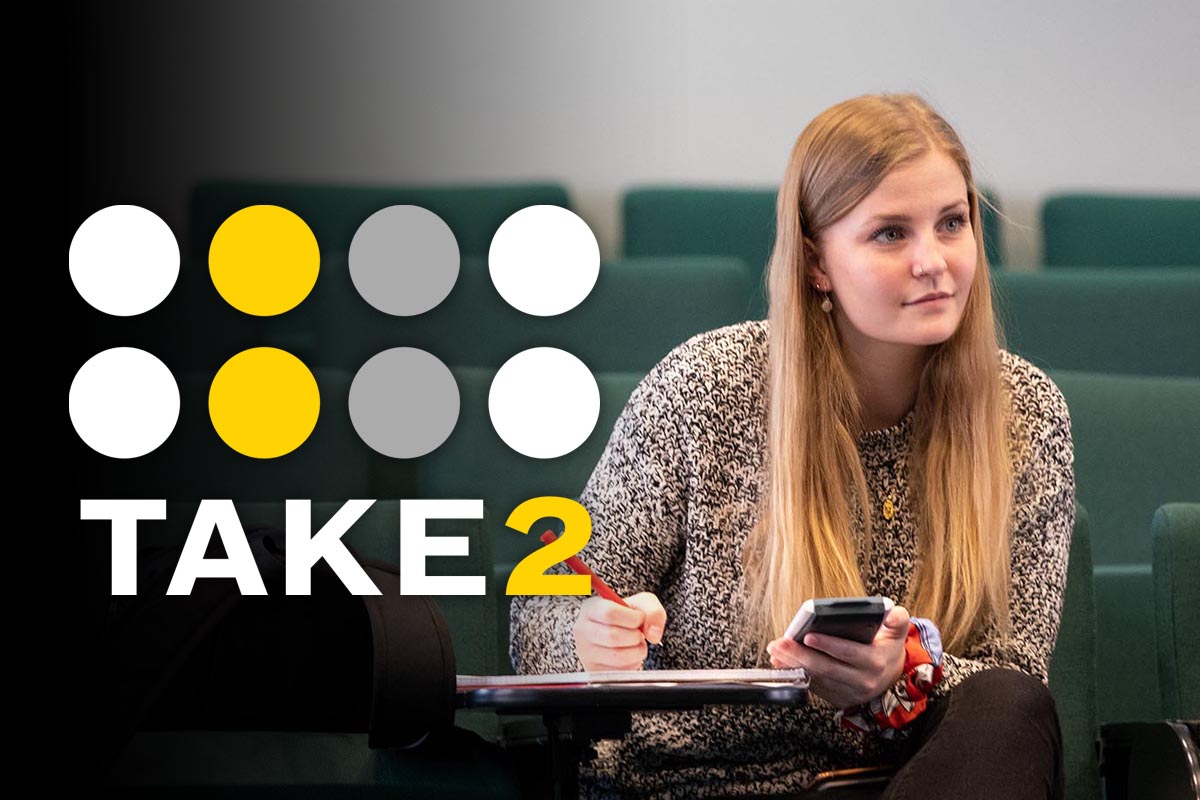Heat of the summer: Students research effects of climate change, heat stress on seagrass beds

(From left) professor Sarah Sojka, Alex Kulvivat, Paige Edwards, and Jdody Misidor in the water along the eastern shore of Virginia.
Alex Kulvivat ’22, an aspiring aerospace engineer, has always enjoyed building and creating things. Though he knows the path to achieving his career goal is a long, difficult one, he is already gaining plenty of field experience.
“Back in high school, I made a couple of products, and one was a posture training device,” Kulvivat said. “It’s a little square pack you put on your hip, and if you slouch, it will buzz to remind you to correct your stance or sit up straight.”
Kulvivat is now putting his engineering skills to the test at Randolph as part of a Summer Research project with Jdody Misidor ’21 and Sarah Sojka, a physics and environmental studies professor. During the eight-week program this summer, the group is examining the effects of heat stress on seagrass beds along the eastern shore of Virginia.
Located off the peninsula north of Virginia Beach, the area is one of the largest, most successful seagrass restoration sites in North America. Seagrass plays an important role in maintaining water quality and provides a source of food and habitat for marine life. After being wiped out by disease and extreme weather nearly 70 years ago, seagrass beds have started growing along the eastern shore once again, thanks to previous efforts by Sojka and other environmentalists from the University of Virginia. However, they now face a new threat from underwater heat waves.
“In 2015, we noticed that we lost large chunks of seagrass beds during a marine heat wave that summer,” Sojka said. “These marine heat waves are going to get more common with climate change, so we’re trying to understand the process and how the seagrass can or can’t recover.”
Sojka noted that benthic microalgae could play a significant role in the health of the seagrass beds moving forward. The microalgae produces a slimy, carbohydrate substance similar to plaque on teeth called polysaccharide, which grows on the seagrass. For the project this summer, Sojka and the students are working to find out if the polysaccharide is helping or harming the seagrass depending on its reaction to sunlight, temperature, and water movement.

(From left) Jdody Misidor, Alex Kulvivat, and professor Sarah Sojka collect sediment samples from the water
Earlier this summer, Sojka, Kulvivat, and Misidor traveled to study the seagrass beds at the Anheuser Busch Coastal Research Center in Cape Charles, Va. They placed censors in the water to measure light intensity and temperature and took sediment samples from the beds. Paige Edwards ’21 also assisted the group in collecting samples and is staying at the research center this summer as part of a special Research Experience for Undergraduates (REU).
While the rest of the group has returned to Randolph, Edwards will remain on site to continue monitoring the benthic microalgae and its effects on the seagrass through the end of the summer. Meanwhile, Sojka, Kulvivat, and Misidor will place the samples they gathered in an environmental chamber and observe the microalgae as it grows and reacts to different conditions.
“It sounds a little goofy to spend eight weeks setting up an experiment, but experiments mimicking tidal environments are a pain,” Sojka laughed. “It’s not just about planting the microalgae. We also have to figure out how to get enough water movement, how we control the light and temperature appropriately, and whether the water should move up and down or side to side in the chamber.”
That’s where Kulvivat’s engineering experience comes in. He has sketched out models for water movement and lighting, and is planning a test run before the end of Summer Research. From there, Misidor will collect data on the microalgae’s responses and compare it with the seagrass beds Edwards is monitoring on the eastern shore.
Kulvivat and Misidor both wanted to participate in Summer Research for the opportunity to conduct hands-on work in their fields and to play a part in helping solve a real problem.
“I love learning about biology, especially marine biology, so as soon as I heard seagrass I hopped right onboard,” Misidor said. “It was also a great opportunity to work with a physics engineering major, Alex, and with one of my advisors and favorite professors, Dr. Sojka.”
Misidor is an environmental science major and wants to use her skills to help her home country of Haiti.

Alex Kulvivat (center) tests the environmental chamber at Randolph while Sarah Sojka and Jdody Misidor stand by
“The change that I want to bring about in my country is what inspired me to do environmental science,” she said. “When I get older, I want to go back and reestablish my citizenship there and run for president. And if I don’t become president, I want to at least make a difference there by helping the environment.”
Kulvivat is also aiming high with his career goals. He is currently enrolled in Randolph’s 3-2 program, and if he doesn’t become an aerospace engineer, he wants to be a fighter pilot.
“It all started when I was a toddler,” he said. “My dad worked for the Department of Defense, and we moved around the world all the time and I met all these fighter pilots and military officers who inspired me.”
Kulvivat is one of only two rising sophomores in the Summer Research program this year, and relishes the opportunity.
“In my field it’s really competitive to get internships or jobs during undergrad, but you have to have experience and have to start somewhere,” he said. “Very rarely do you see a rising sophomore with an opportunity like this. Most of my friends who are also trying to become engineers are back home flipping burgers this summer, and I’m here getting to apply myself and getting to take an extra step towards reaching my goals.”
Tags: Engineering Physics, environmental science, environmental studies, Jdody Misidor, marine science, Sarah Sojka, seagrass, student faculty research, summer research, summer research 2019
